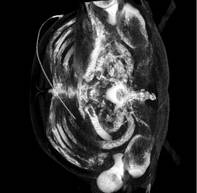Analysis of Direct Volume Rendering Methods for the Visualization of Voxel Data
Dominik Sarnow, Leibniz Universität Hannover,
diploma thesis
12/2007
The content of this work was the implementation and the comparison of different direct volume rendering algorithmens, using datasets of voxels as input.
Today, computer tomography is commonly used to archive a digital representation of the human body or body parts. One way the archieved data can be interpretated, is as a set of voxels. Voxels are small three dimensional cubics with an internal value. In medicine those values are generated by x-rays traversing the human body. They get partial absorbed and the final energy, when they leave the body, is measured and can be visualized as a grey value for the coresponding voxel.
 In this work, those voxelsets are the input data, that should be visualized. Different methods how this input data can be visualized exists, belonging to the categories of
In this work, those voxelsets are the input data, that should be visualized. Different methods how this input data can be visualized exists, belonging to the categories of
- Ray Casting,
- Splatting,
- Shear Warp and
- Texture-Based Algorithms.
The goal of this work was to implement a candidate of each category and compare the results by runtime, memory usage and optical impression.
Parent Project: YaDiV
Kontakt: Karl-Ingo Friese

